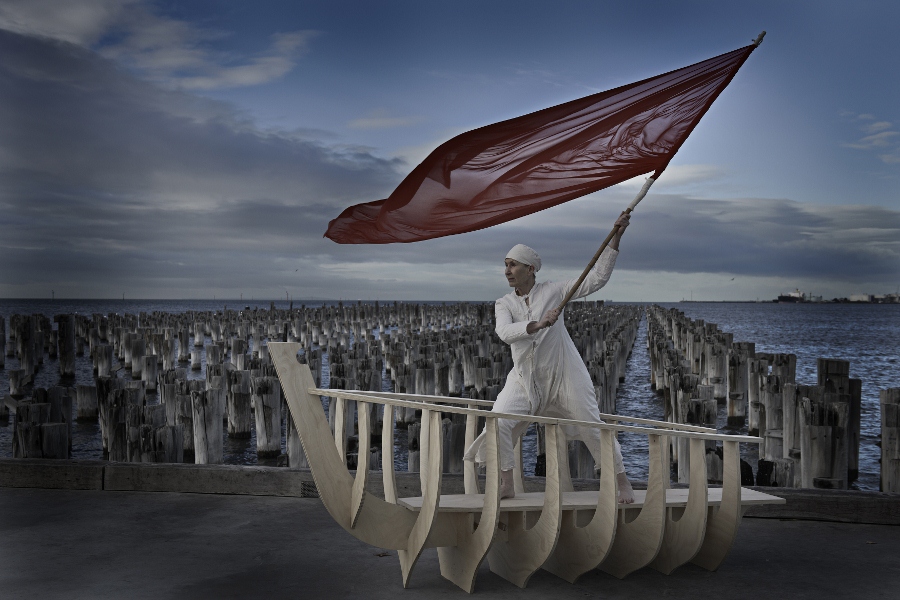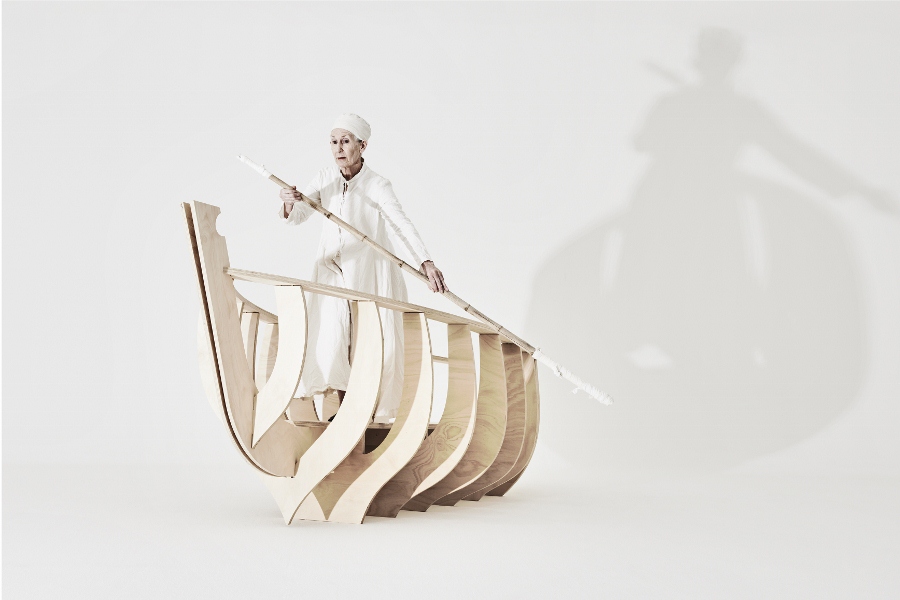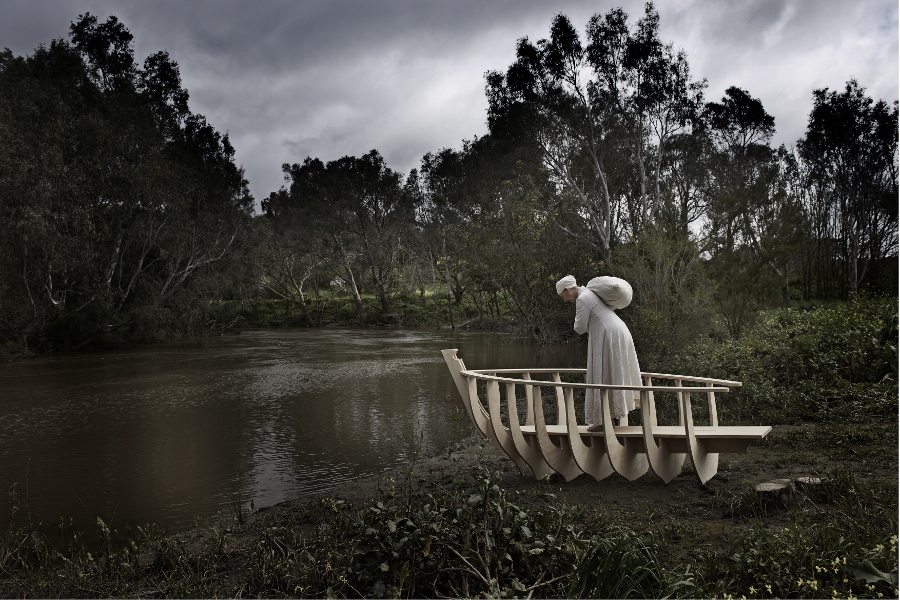Jill Orr, The Promised Land, Part 1

Jill Orr is one of Australia foremost artists. For over 40 years, Orr has enlivened Australian and international audiences with her work and performances. Orr has been a protagonist of performance art, from her early iconic works such as ‘Bleeding Trees’ through to ‘From the Sea’ and ‘The Crossing’ through which she has explored such issues as the resonances of land and meeting of cultures. Her work has focused on the psycho-social and environmental facets with a deep commitment to humanity, a compassionate openness and depth of vision which embraces, engages and inspires curiosity and contemplation. In this two part interview, Claire Bridge spoke with Jill for Art World Women about her current work and exhibition ‘The Promised Land’. In Part II we look more closely into Jill Orr’s perspective on of being a performance artist, body image and the role of emotion and how she goes from idea to performance.
image above: Jill Orr The Promised Land – flag, 2012, Photographer: Christina Simons for Jill Orr, © Jill Orr 2012
AWW: You seem to be able to evoke stillness and the immense efforting of movement simultaneously. This speaks to me about an ability to invoke a specific resonance and quality of “beingness”. How do you approach your performances? As an actor stepping into a role and a story, or as someone becoming in the experience? What is it like for you?

JO: I see the performance as an activation or animation that completes or instates the works’ process into life. It is more as you have suggested, beingness, which I see as presence in the moment. Something happens in this state of complete focus that cannot be completely predicted, or replicated but the body holds itself and in a sense ‘transmits’. It is the moment of transmission that is communicated through the photographs. This is very different to acting or pretending to be something else. I do have a pretty good idea of what the images will look like and work with the photographer to achieve this. The performative focus is not achieved in an ordinary state, I think because the body is not fully engaged in the process of the task. Very different photographs emerge but they are not performative which for me, is where presence can be communicated.
AWW: Your work doesn’t shy away from the confronting or complex issues we face as a society in contemporary times. You have the ability to dive in deep into these difficult and multi-faceted issues and present them in ways which intrigue and invite closer contemplation. How do you find that balance? What guides you in walking the line between issues and audience?
JO: There are three things that must be present for me to develop a work. Firstly the issue, question or aesthetic journey must have a personal resonance that I can learn from and engage with deeply. Secondly it needs to have relevance beyond myself. Not that the personal is not political but I like to look at both the breadth of an issue that can be reflected historically, politically and humanely where my contribution is part of a larger whole. Thirdly that an image or an action has a strong imaginative presence that I cannot deny and that is what I focus on throughout the work’s creative process. I have recognised these factors as a gift that I must trust and it is the trust that forges the link between issues and the audience.
AWW: Land. The word is a potent one in Australia, overladen with multiple meanings. ‘Land’ has meaning for indigenous Australians and quite different meanings for non-indigenous Australians. You have addressed these cultural and societal issues in other works, the crossing points, the crux of the meeting between cultures and peoples. How does ‘The Promised Land’ continue this conversation?
JO: I think ‘The Promised Land’ continues the meeting between cultures and peoples through the deeper allegory of seekers. Whether that be the search for land, peace, faith or refuge, this need and desire is fundamental to human existence and has compelled and propelled journeys despite immense danger. The urge goes deep into the very instinct to survive and live in a sense, beyond the self, for future generations. It is both vividly seen in contemporary life and throughout history. Survival and promise are the impetus behind myth, religious story and heroic rites of passage across time. ‘The Promised Land’ evokes all of this and yet is also a reference to the present asylum seekers.
In reference to Australia, as the site of the work, it is added to by the history particular to each site although this site history is not necessary to view the work. I was really thinking of a European context where the work will be viewed in the inaugural Venice International Performance Art Week, and was imagining the impact of the global financial crisis. I am also aware of the Arab Spring where civil uprising seen in the collapse of dictatorships, through the power of people demanding regime change which finally succeeded in Tunisia, Egypt, Yemen and Libya.
The powerful force for change seems to be galvanized by the role of social media in gathering mass response. This appears to be an unprecedented change and tool for the realization of a Promised Land. But the promise here is implicated with the best and worst of democracy which is ultimately founded on capitalism and growth at all costs. The West needs Middle Eastern oil, so the image of promise is never pure as a political lure however democracy as an ideal is full of hope and possibility for all. The work, The Promised Land, resides between the screen of desire and the need to survive, it is an imagined place that has potential for the future life. The strength of the imaginary is that it is seen before it can become manifest.

AWW: When considering the title of your show ‘The Promised Land’ it brings to mind the potency of religious ideas – Jewish and Islamic traditions. It recalls Moses, “the promised land”, the discovery of land, colonisation and settlement, the promised land of refugees searching for a safe haven, “boat people” and many more evocations. What meaning does the title hold for you?
JO: The title has all of the resonance you have mentioned. I do want the work to penetrate beyond the daily politics and the rich overlay brought through associations to the title enable interpretive multiplicity.
AWW: The boat form you use in ‘The Promised Land’ is the skeleton ribs of a boat. It can not sail. It seems to remind us of death. It seems to speak to the impossibility and hopelessness of ‘the Promise’ – or does it?
JO: I suppose I have a touch of black humour and the sense of the ridiculous. Indeed this boat will not float but maybe it does!
AWW: What is your message about asylum seekers and immigration?
JO: I don’t really have a message. I think that viewers have their own minds and I am not going to tell them what to think. I hope the images can be viewed and interpreted openly and in that viewers take with them what they need. Art may be political but it is not politics. Art, I think, needs a deeper enquiry beyond the daily occurrences that largely occupy politics. For me, art meets politics in philosophical, ethical and psycho-social realms, to name a few.
AWW: Flags, symbolic of triumph and surrender. A blood red flag . Is it covered in the blood of those sacrificed, or murdered for the land, or of those who have died on the journey? Or is it the red of life blood, like Delacroix’s “Liberty leading the people”, the red of optimism and triumphalism? Is it a flag of nationalism , or a warning, a signalling of distress from a sinking ship?
JO: The ‘Raft of Medusa’, Gericault’s great painting, and Delacoix’s ‘Liberty Leading the People’ were references for these images both as images of disaster and of power to the people uprising. I did not want a specific nationalism and chose the drama of a plain red flag. It was Christopher Heathcote’s question to me, as he was writing the catalogue essay, when he asked me if the flag was blood. I responded that blood has been spilt in most uprisings from history, the current Middle Eastern uprisings record thousands of deaths. It is a plausible and powerful association that art history and associative image conjure blood in the reading.

AWW: What choices do you make about setting and the ‘stage’ of your photographs and performances? In ‘The Promised Land’ your settings are as diverse as the white cube of the gallery, to out in the environment: a dock with the giant ferry “Spirit of Tasmania”, an open beach and ocean, a dockland/harbour, to an inland lake surrounded by gumtrees and the evidence of human intervention on the landscape. How have you come to decide on these settings?
JO: The sites are extremely important to staging the work. The white cube emphasises the shadows emerging and disappearing leaving the actions and the boat as the sole work devoid of anything else. This is how the live performance will be seen. The beach with the Spirit of Tasmania in the background enable the natural shifting light of dawn to work with the image as an incongruous contrast in scale to both the immensity of both the beach and the ferry. Both dwarfing my boat and self. The images on Princes Pier, despite the intrigue of the pylons in the background was the site for immigrants from both World Wars. These arrivals are now the fabric of Australian society. The shots on the Yarra River flats are where I take my dogs for walks. This is actually the site where the Heidelberg artists, Arthur Streeton, Frederick McCubbin and Walter Withers amongst others, painted idyllic landscapes in the late 1800’s. I do find that set on the river, in that specific place, does seem to evoke the Heidelberg school. That’s an interesting surprise that has happened. The sites are imbued with their own history that adds to the primary aesthetic choice to stage the work in each of them.
AWW: Your work appears to reference the work of other artists and in doing so seems to bring in other streams of narrative and layered readings of your work. In The Promised Land there appear to be references to Millet’s iconic works The Gleaners and The Angelus. Even Woman with a Rake seems to make a haunting appearance. Are these references relevant to this work The Promised Land? Are they intentional, or simply a factor of a perception filtered through a western cultural reference library?
JO: Other than the Gericault and Delacroix, regarding the flag, the actions have come from the nature of boats and travel. I am pleased that you can see the haunting traces of history but indeed it is the cultural reference library at work that means that we are never on an island dissociated from time and place which enable richness for the viewer to dive in should they wish.
Read more of Jill Orr’s interview in Part 2 here
‘The Promised Land’ is hosted at John Buckley Gallery Richmond, and will continue through to Oct 20th. Jill Orr is represented by Jenny Port Gallery.
Photographer: Christina Simons for Jill Orr
All images copyright Jill Orr 2012
2 thoughts on “Jill Orr, The Promised Land, Part 1”